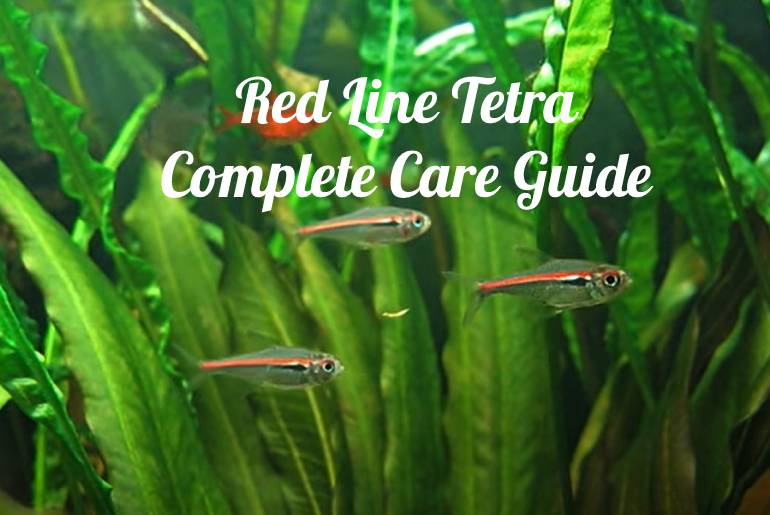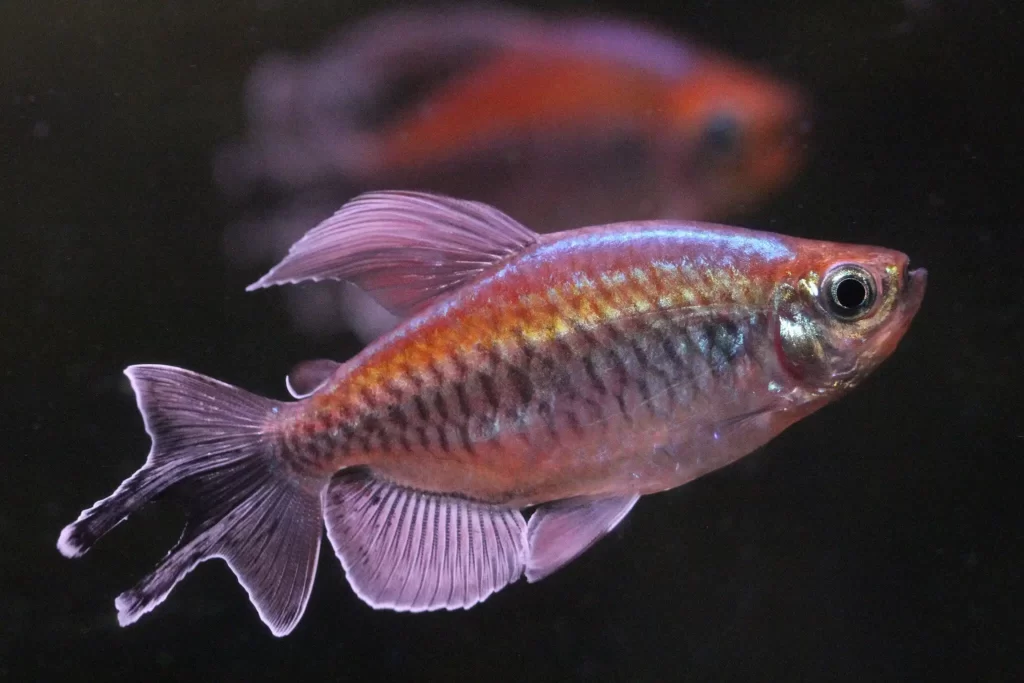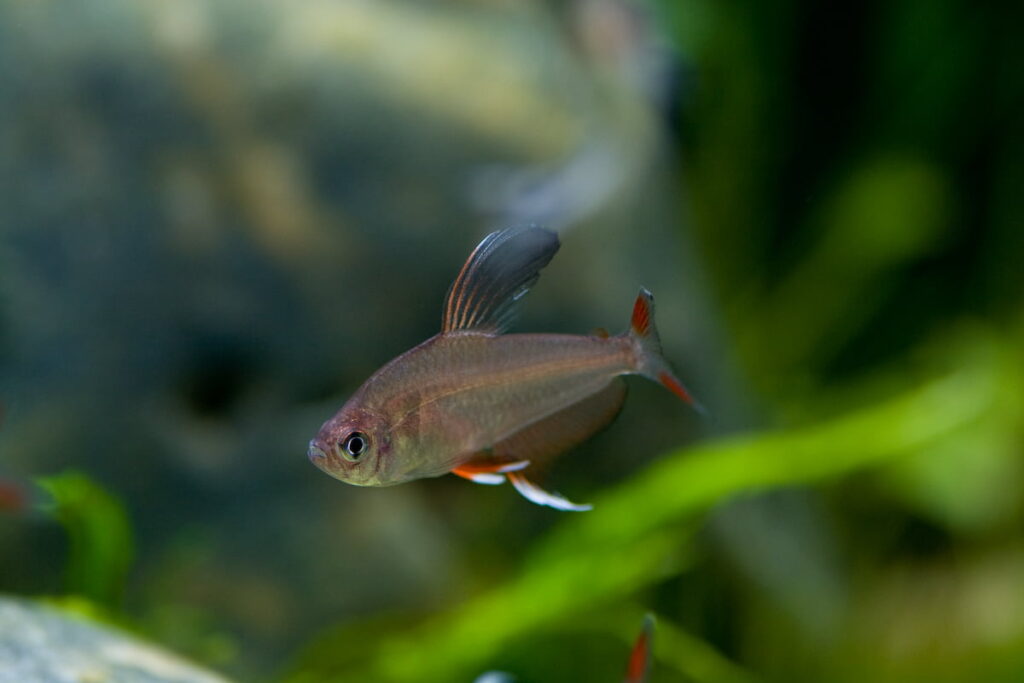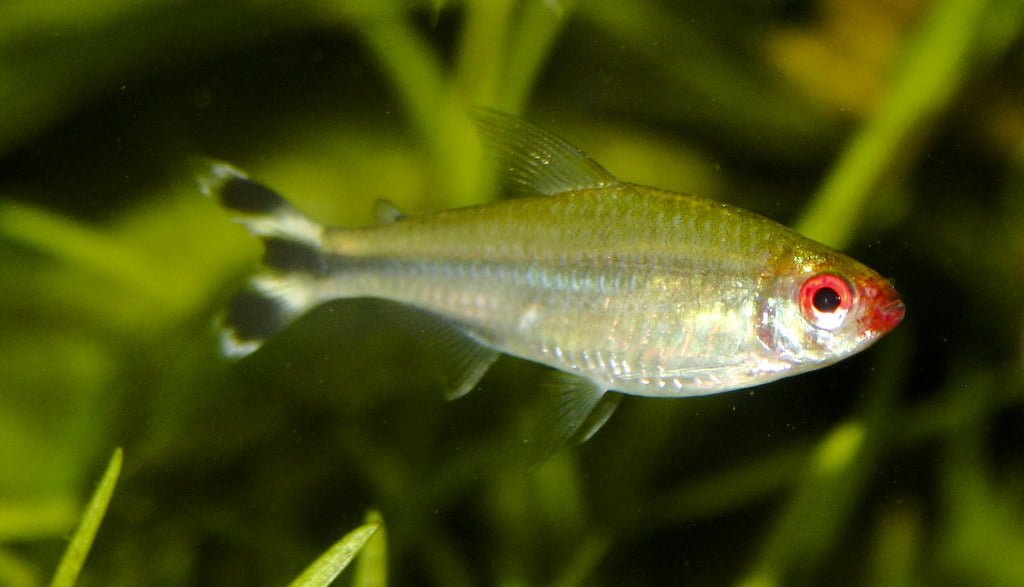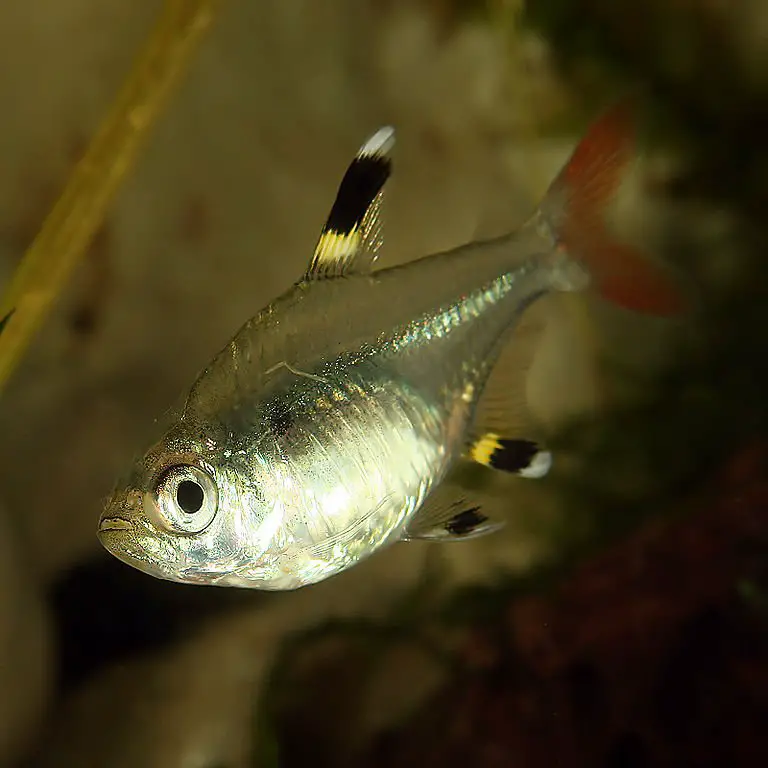Tetras is one of the most preferred species worldwide as people love to keep them in their home aquarium. The tetras are freshwater, tropical fish that are small yet colorful, and vibrant. When talked about tetras, people often have neon tetras in their subconscious mind but it isn’t quite true. There are many other beautiful and attractive types of tetras such as Congo Tetra, Black neon Tetra, Black Skirt Tetra, Red line tetra, etc. Let keep all the tetras aside and talk about Red line tetra today.
Red Line Tetra are tetra fish that have a combination of grey, silver, red, black, and yellow on their body. They are a little smaller than the other tetras so you might fall in love with them if you prefer small-sized fish.
These red line tetras have many names including Amapa Tetra and Scarlet Tetra. They got the name Amapa Tetra because of their origin; these tetras are originated from the Amapa River in Northern Brazil.
In this article, you will learn how to take care of Red Line Tetra while knowing its appearance as well as its natural habitat. Alongside all these, I’ll help you with the breeding of Red Line Tetra too.
Red Line Tetra Overview
A school of red line tetras, shoaling together in the aquarium can surely brighten up your mood. If you have a school of them or are planning to bring them home, then I must say you have a good choice of fish.
Even though Red line tetras are not so commonly found in aquariums, they will make quite a good impression in the tank.
Red Line Tetra is native of North-Eastern Brazil as I already mentioned they belong to the Amapa river in northern brazil.
Now coming to the scientific name of the red line tetra, it is quite meaningful and easy to remember.
The scientific name of these tetras i.e., Hyphessobrycon amapaensis has a literal meaning as well. Brycon is the species name of the red line tetra and hyphesson means “less stature” in ancient Greek.
Now the genus amapaensis indicates Amapa state in Northeastern Brazil. Thus, the literal meaning of their scientific name is “small heightened fish of Amapa”.
Isn’t it kind of unique and fascinating?
These tiny tetras have a peaceful temperament and can easily adjust to the community aquariums with fishes of similar size. Red lines like most of the tetras are very easy to keep.
Red Line Tetras
| Common Name | Red line tetra, Scarlet Tetra, Amapa Tetra |
| Scientific Name | Hyphessobrycon amapaensis |
| Family | Characidae |
| Size | 2.5-3 cm |
| Origin | Brazil. |
| Life Span | 3-5 years |
Appearance
Red line tetras are small tetra fish with a silver-colored body. In that silver color, you will see a thin red line running in the middle of the body starting below the head to the tail.
This red line is where they get their name Red Line Tetra from. Along with all the colors around, this red line catches your attention.
Below the red line, right behind its head, there is a small black mark and the upper part of its eye is red-colored.
Also, you will see a very thin yellow line running below the red line in the Red Line tetra’s body.
However, the fins of the red line tetras are colorless or slight yellow while the anal fins have 18-20 branches.
Some people get confused between Belgian flag tetra (Hyphessobrycon heterorhabdus) and red line tetras but if you look closely, there is a huge difference.
Differentiating Male And Female Red Line Tetra
The body size of the red line tetras gives away the gender of these fish. You just need to know how to look and where to look.
The female red line tetras have a bigger belly than that of their male counterparts. Along with that Female red line, tetras are larger in length as compared to males.
Water Parameters For Red Line Tetra
The Red Line Tetras were discovered from clear stream water in Brazil. These stream waters normally have a pH ranging from 5.8 to 6.3.
So, you can see their inclination towards acidic and soft water in the nature and same thing in the aquarium.
Let me help you with the water parameters these Red line tetras ask in the tank:
| pH level | 5.8 to 6.3 |
| Temperature | 73 to 82℉ (23-28℃) |
| General Hardness | less than 8 dGH |
Maturing Tank Water For Red Line Tetra- The Nitrogen Cycle
Maturing tank water means developing beneficial bacteria colonies in the aquarium so that it regulates the nitrogen cycle.
Ammonia Poisoning is lethal to any fish, even tetras, and these red lines are sensitive as well. The Aquarium Nitrogen cycle converts the toxic ammonia into essential compounds that plants use.
Before adding the red line tetras to the aquarium, you need to keep and grow the beneficial bacteria that break ammonia to nitrite and nitrate in the tank.
So, you should cycle the water tank once in a couple of weeks to prevent the ammonia spike in the tetra tank.
How Do I Mature A New Tank?
Once you purchase a new tank, do not fill water in it directly or add the red line tetras immediately to it.
Mature the tank water first while maturing the aquarium may take approximately two weeks, you have to wait a little while before adding the fish in the tank.
Firstly, clean the aquarium, add water, and essential equipment like filter and heater in the aquarium.
Hitop Submersible Adjustable Aquarium Heater and Penn Plax Cascade 400 Submersible Aquarium Filter are an ideal choice for an aquarium heater and aquarium filter in the tetra tank respectively.
Then, add ammonia that is easily available in the pet shops until the level reaches between 5 to 20 mg.
When ammonia spikes to that level, stop adding the ammonia but test the water daily. API master test kit will help you while checking the ammonia level every day.
Subsequently, Ammonia levels will be stable for a few days and then decrease gradually. Once the ammonia drops to 0 mg, it means you have succeeded in developing the bacterial colonies in the aquarium.
Cleaning Tank with Red Line Tetras
The tank with red line tetras needs to be cleaned periodically. It all depends on the size of the tank and the gallons of water you use.
If you are using a small (5-15) gallon tank, then you need to change 10-15% of the tank water every week.
Using 15–60-gallon water, you can change up to 25% of tank water every 2 weeks. A tank larger than that also needs water change per two weeks.
Be careful not to change more than 50% of the tank water at any point of the time. As tetras are sensitive creatures, they cannot resist sudden changes in water parameters.
Also, check all the supplies time and often that you might use in the aquarium monthly or every six months.
Breeding Tetras- Red Line Tetra Complete Care Guide
It is natural to see some fry popping up in the aquarium when there is both male and female Red Line tetra present.
But this is only applicable for the ones who don’t want more fry and is okay with the few that survive in the main tank.
If you want to have more fry for commercial purposes or to have a few more of them in the tank, you need to take the necessary steps.
You see red line tetras are not one of the fish with parental instincts, so you will need completely new breeding or fry tank.
I’ll help you with the breeding steps, a simple instruction when you follow properly will pay off with many fries.
But you need to be prepared to lose a few of the newly born as neither all the eggs will hatch nor all the fry will survive.
As I already stated these red lines are carefree parents, so you might find them eating their eggs when they get hungry.
I would like to classify the breeding process into three stages namely, the conditioning stage, the actual breeding stage, and the egg incubation period.
Let’s learn in detail about these stages and what you need to do while breeding your Red line tetras.
Conditioning Stage
The tetras should be at least 12 weeks old to be able to breed. In this stage, you should feed the male and female red line tetras enough nutritious diet.
Feed them live and frozen food more so that they are healthy and they contribute to spawning. Ensure that spawning does not take place in the conditioning stage itself.
For conditioning only and to avoid spawning in this stage, you can use a separate tank with a divider in it.
You will keep the female red line tetras on one part and the male red line tetras on the other.
Also, you can use a community aquarium itself with many fishes on it. So that the tetras don’t become stimulated to mate.
Actual Breeding Stage
There are few things you need to prepare beforehand so that you can provide a good environment for tetras while Breeding.
Here is an article about Breeding Tetra Fish – Step By Step Guide. This guide will help you know the detail about breeding tetra fish.
Tank Requirements
For the actual breeding stage, you need to use an extra small tank i.e., 5-10 gallons. You need to lower the pH level and temperature significantly as compared to the community aquarium.
Place a plastic grate and spawning mat at the bottom of the aquarium so that the parents’ tetras do not eat the eggs that fall to the bottom.
Use plants like java moss or artificial spawning mop to give proper space for tetra fish to lay their eggs on.
Filtration And Heating The Tank
You can use the same community tank water or aged acidic water in the breeding tank. Use peat moss for filtration and lowering the pH level.
Use a sponge filter and heater in the breeding tank as you used to do in the regular tank. If you use peat moss, it may take 2-3 days to settle down.
You can use the AQUANEAT Aquarium Bio Sponge Filter in the red line tetra breeding tank.
The pH of the breeding tank should be 5-6 and the temperature should be 25℃. Make sure that you match these water parameters.
Lighting
When all the conditions are met and the tank is properly set, transfer the male and female tetras to the breeding tank after sunset.
Ensure that the tank is dark. If there is any source of light that hits the breeding tank, cover the tank with a towel or any other stuff.
The next morning, uncover the breeding tank and let the soft sun rays face the breeding tank. If it is not possible, switch on the dim light in the tank.
Keep in mind, the light should not be too bright or disturbing to the red line tetras. After some time, the tetras will start the spawning process.
You will see eggs scattered on the floor, plants, or the spawning mop of the aquarium.
Incubation Of Eggs
Once you start to see the white or yellowish cluster of egg with a black dot inside, move the parents back to the main tank immediately.
These parents lack the care for their eggs and eat them while they are hungry and grazing for food. You need to provide them sufficient food to avoid this blunder before the male hatches these eggs.
Now, after removing parents from the breeding tank, you need to convert this very tank into a fry tank. Not that you have to change all the things upside down.
All you have to do is remove any source of light present in the tank, these eggs develop in the dark environment.
Almost after 36 hours, you will find the fry hatching from the eggs, they might still be with the yolk sac though.
Don’t feed them immediately or change any of the water parameters. If you want to have a good and healthy red line tetra, you need to take good care of these newly born.
Coming to the feeding, there are a few options for the food you can go with while feeding the tetra fry.
Infusoria and newly hatched brine shrimp are the most recommended fry food when it comes to feeding your new tetra.
You might Like to read an article on How To Make Tetra Fry Grow Quickly?
Red Line Tetra – Illness
If you are familiar with any other aquarium fish, you will know what inappropriate water parameters can do to them.
Red line tetras are not different as well, if you add them in the tank with inappropriate water parameters and without acclimating, you might not like the consequences.
If you add new fish directly to the tank without quarantining it, this might affect your already existing aquarium fish.
You need to quarantine the new fish in a separate tank for a few weeks. Quarantining helps to prevent the spreading of diseases among other tank mates
After a couple of weeks, if they still act normal or show no symptoms of illness, then you can add the new fish to the main tank.
Diseases follow the inappropriate water parameters in the tank and affect the fish present in the tank. Hence, Ich, Fin Rots, etc. are the common diseases that can affect Red line tetras.
Most of the disease that is common among tetra family is susceptible to redline tetras as well. Although they are hardy, some fluctuation and inconsistency tend to bring bacterial and fungal infection.
If you see any of the symptoms given below in your red line, move that particular fish to the quarantine tank immediately and take the necessary measures:
- Loss of appetite
- Abnormal Swimming
- Swimming on the top or bottom-dwelling.
- Leaving the school behind
- White spots on the body
- Gasping
- Rotting fins
- Lethargy
When you come across these symptoms and after you quarantine them, consult your regular fish shop or the vet.
Frequently Asked Questions
Here are answers to few FAQs on Red Line Tetra, you might be wondering about as well.
How Much Does A Red Line Tetra Cost?
Well, the cost price might also be the reason these tetras are not as common as any other tetras. Red line tetra will cost you around $7 to $8. Similarly, if you are planning to keep a school of these tetras, it might seem costly.
But hey, these tetras are worth it, they will accompany you happily for 5 years blessing you with a beautiful aquarium.
Are Red Line Tetra And Scarlet Red Line Tetra Same?
No, scarlet red line tetra (Hemigrammus Coeruleus) and red line tetra (Hyphessobrycon amapaensis) are not the same.
Although these Red line tetras are often called Scarlet tetra, Scarlet red line tetra is something completely different.
You can differentiate these red lines from the scarlet red line with the red color. The Brazilian red line tetra only has a red line in their body whereas the South American scarlet red line tetra has red color on their whole body except the head.
Last Words
Briefly, if you want to decorate your aquarium with “the not so common fish”, then the red line tetras can be one of the best options to keep. So, these small fish of Brazil can be the cherry on the cake in the pre-established aquarium. You can decorate your tank with these peaceful, social fish for 5 years if you take good care of them. So, just remember you are taking up the task to pet one of the most sensitive living beings, act like that. Apart from all this, I do agree you have a great choice if you are looking forward to keeping these red line tetras in your home aquarium. I hope this care guide I have written on red line tetra helps you with all the questions you wanted answers to. You will do great, just follow the simple instructions.
Good Luck!!!
Happy fishkeeping!!!
Picture credit: https://www.youtube.com/watch?v=QSMSNoFthZ0
